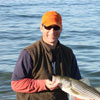Saltwater Fish Species: The Striped Bass
By Tom Keer
Dec 07, 2016
Striped bass are among the most sought-after species on the Eastern seaboard. Fish for them during the day or at night in just about any kind of terrain with any kind of tackle.
The striped bass is one of the top gamefish along the Eastern seaboard. It doesn't matter if you call them by one of their many nicknames of Rock, Linesiders, Brown Dogs, or Old Pajamas. They're among the most sought after saltwater fish species from Virginia to Maine.
Beginning around mid-March, striped bass migrate in schools. They leave their wintering grounds in Virginia's Chesapeake Bay and push along the Mid-Atlantic and into New England. Many of these fish spend the summer months in Massachusetts, New Hampshire and Maine. Small to medium-sized fish usually precede the larger fish most of which are covered by sea lice that hitch a ride. When the water cools off in the fall striped bass reverse their direction and head south for the winter. We should all be so lucky.
Another striped bass fact is that stripers feed on a variety of small and large baitfish. Since these predators have mouths lined with what feels like a fine-grit sandpaper they inhale a water column to ingest small bait. Common delicacies are silversides, sandeels, bay anchovies, shrimp, glass minnows, peanut bunker, and crabs. Bass stun large baitfish with a swat of their tails, spin around, and engulf large bait such as menhaden, herring, alewives, and mackerel. By swallowing a large baitfish head-first bass swallow the bait whole. Spooked baitfish fly their dorsal fins which means a frightened baitfish sucked in from behind could get stuck in the bass' throat.
Stripers like cool water, with the optimal temperature ranging from the high 40's to high 50's. They move from shallow inshore waters like flats, saltponds, estuaries, and along beaches into deeper, colder water found along inshore islands, along ledges and in rips and drop offs. Low-light conditions are preferred, and that is a boon to most of us who work during the day. We fish for 'em at night.
Catch 'em on plugs, spoons, soft plastics, live bait or flies. Their white, flakey meat is delicious, and the only way you can ruin a meal is through over-cooking. This year head to the salt to catch a striped bass. You and your family can catch some rays at the beach while putting a fish on the sand.
Beginning around mid-March, striped bass migrate in schools. They leave their wintering grounds in Virginia's Chesapeake Bay and push along the Mid-Atlantic and into New England. Many of these fish spend the summer months in Massachusetts, New Hampshire and Maine. Small to medium-sized fish usually precede the larger fish most of which are covered by sea lice that hitch a ride. When the water cools off in the fall striped bass reverse their direction and head south for the winter. We should all be so lucky.
Another striped bass fact is that stripers feed on a variety of small and large baitfish. Since these predators have mouths lined with what feels like a fine-grit sandpaper they inhale a water column to ingest small bait. Common delicacies are silversides, sandeels, bay anchovies, shrimp, glass minnows, peanut bunker, and crabs. Bass stun large baitfish with a swat of their tails, spin around, and engulf large bait such as menhaden, herring, alewives, and mackerel. By swallowing a large baitfish head-first bass swallow the bait whole. Spooked baitfish fly their dorsal fins which means a frightened baitfish sucked in from behind could get stuck in the bass' throat.
Stripers like cool water, with the optimal temperature ranging from the high 40's to high 50's. They move from shallow inshore waters like flats, saltponds, estuaries, and along beaches into deeper, colder water found along inshore islands, along ledges and in rips and drop offs. Low-light conditions are preferred, and that is a boon to most of us who work during the day. We fish for 'em at night.
Catch 'em on plugs, spoons, soft plastics, live bait or flies. Their white, flakey meat is delicious, and the only way you can ruin a meal is through over-cooking. This year head to the salt to catch a striped bass. You and your family can catch some rays at the beach while putting a fish on the sand.
Popular Posts









